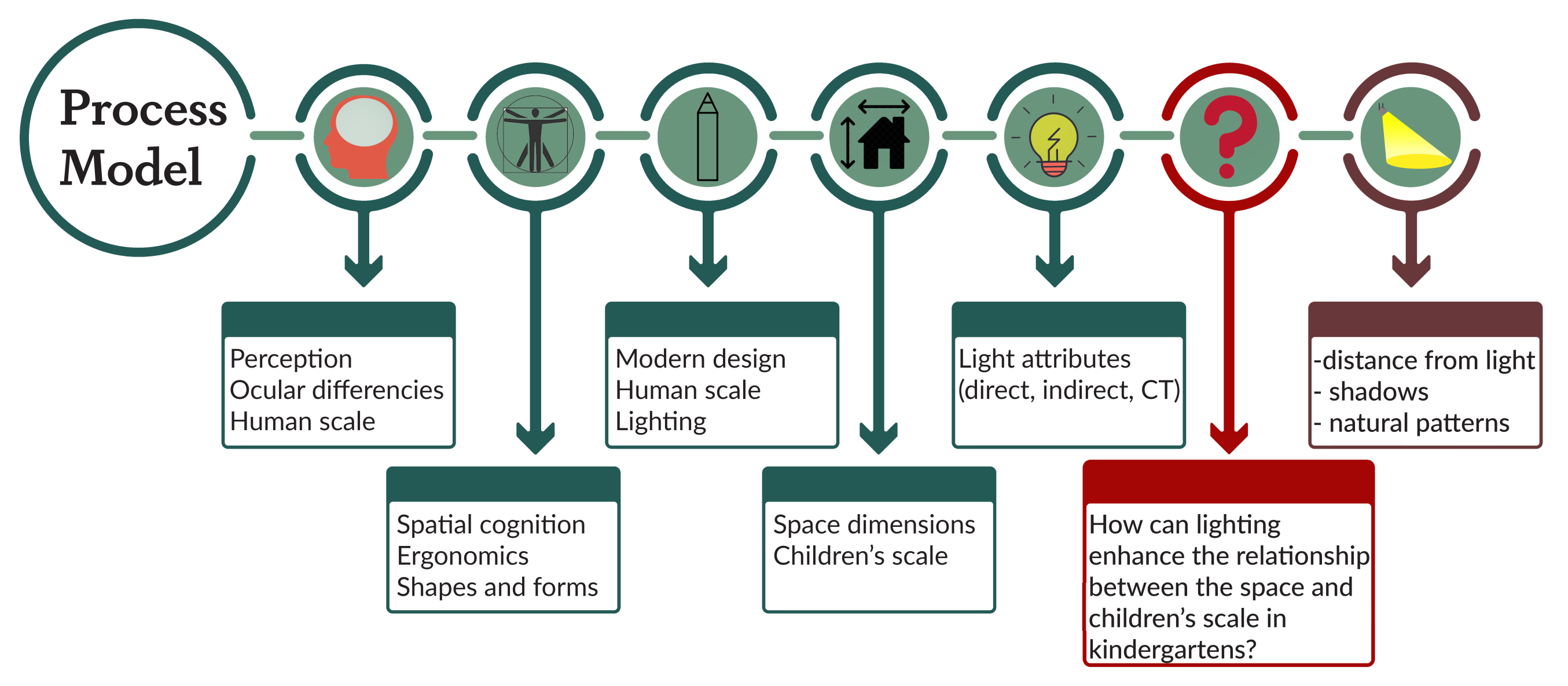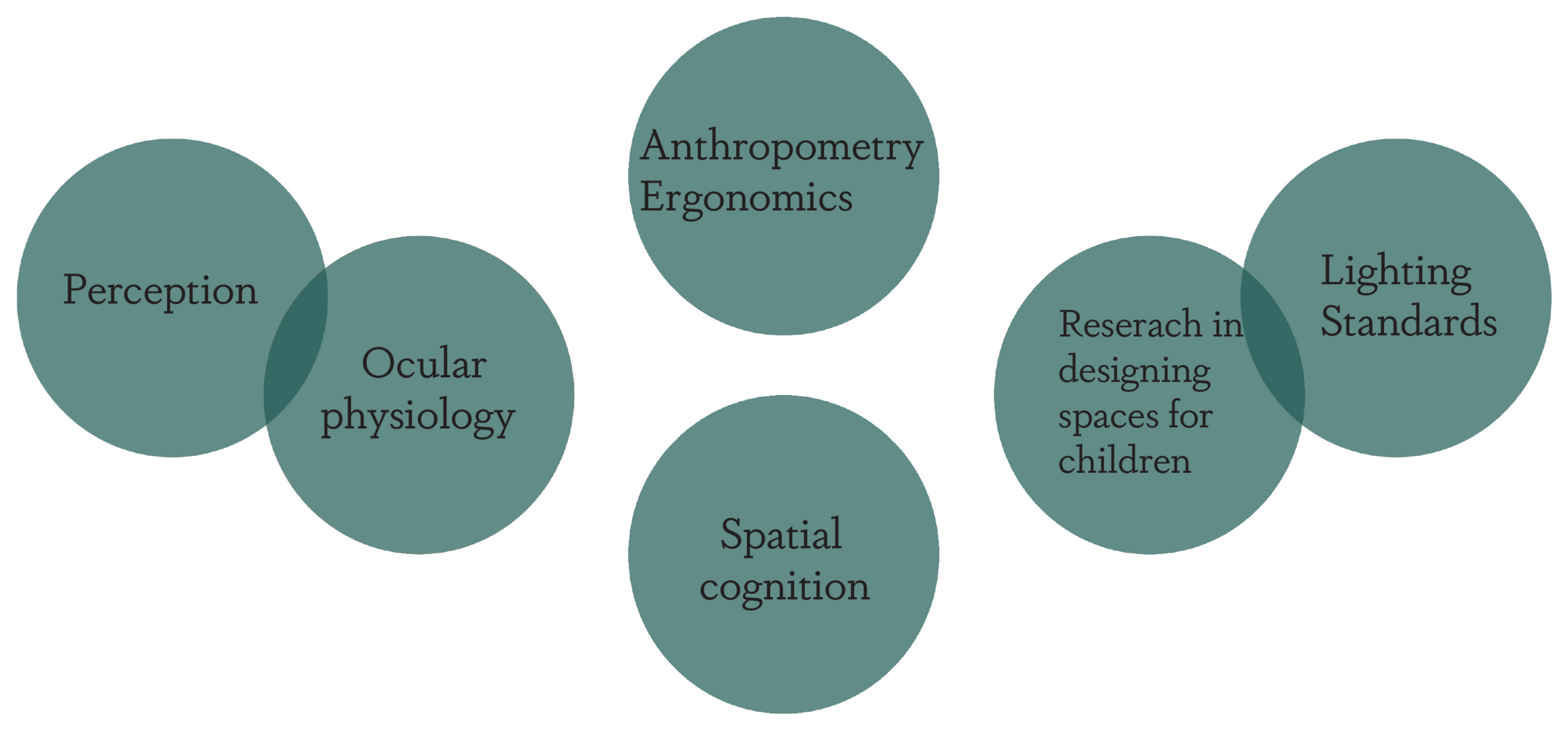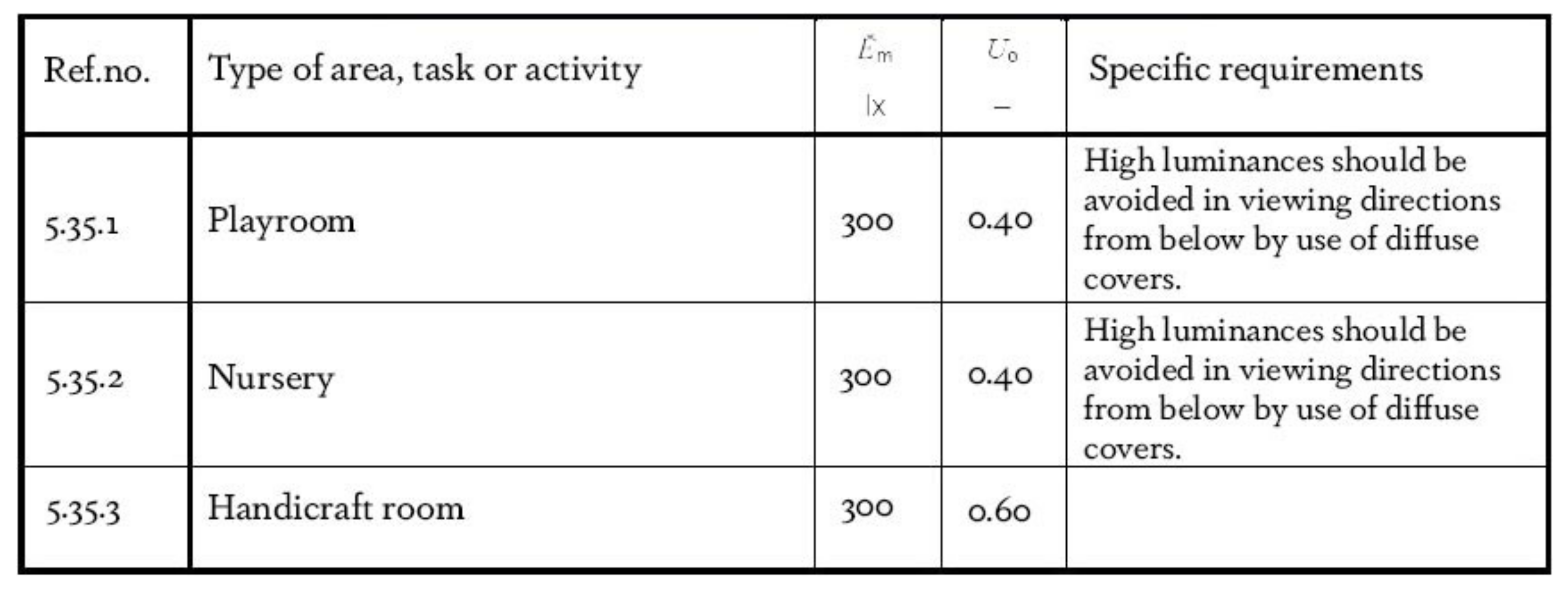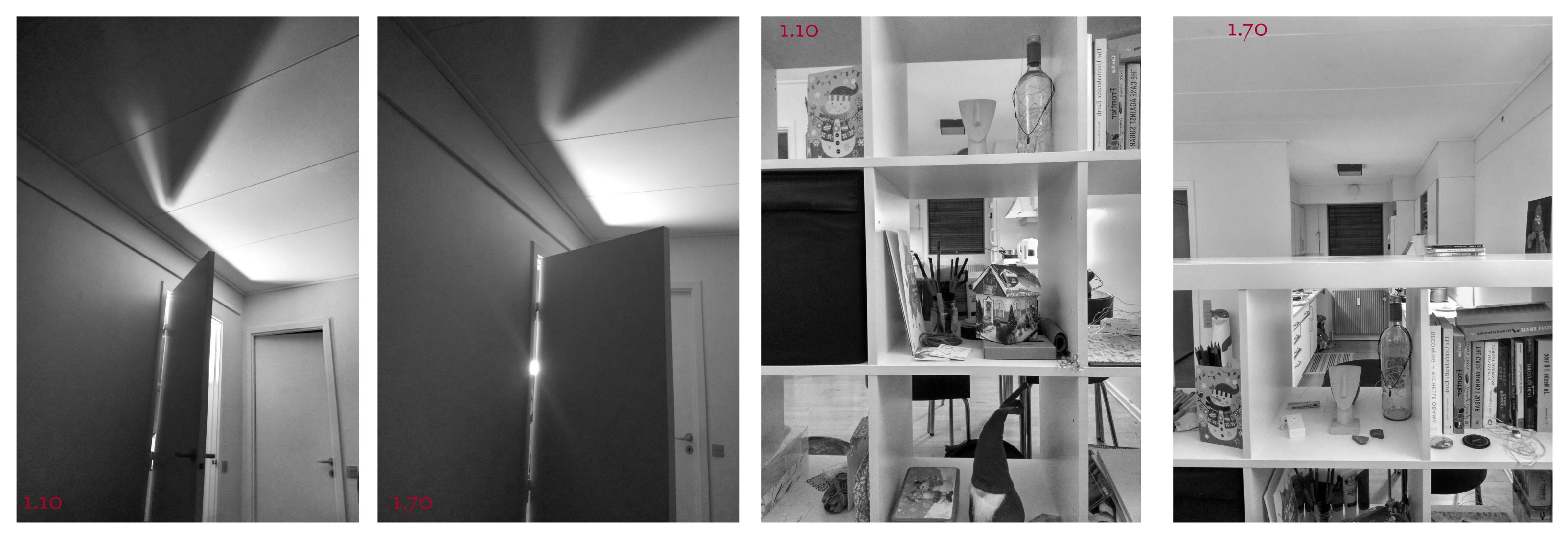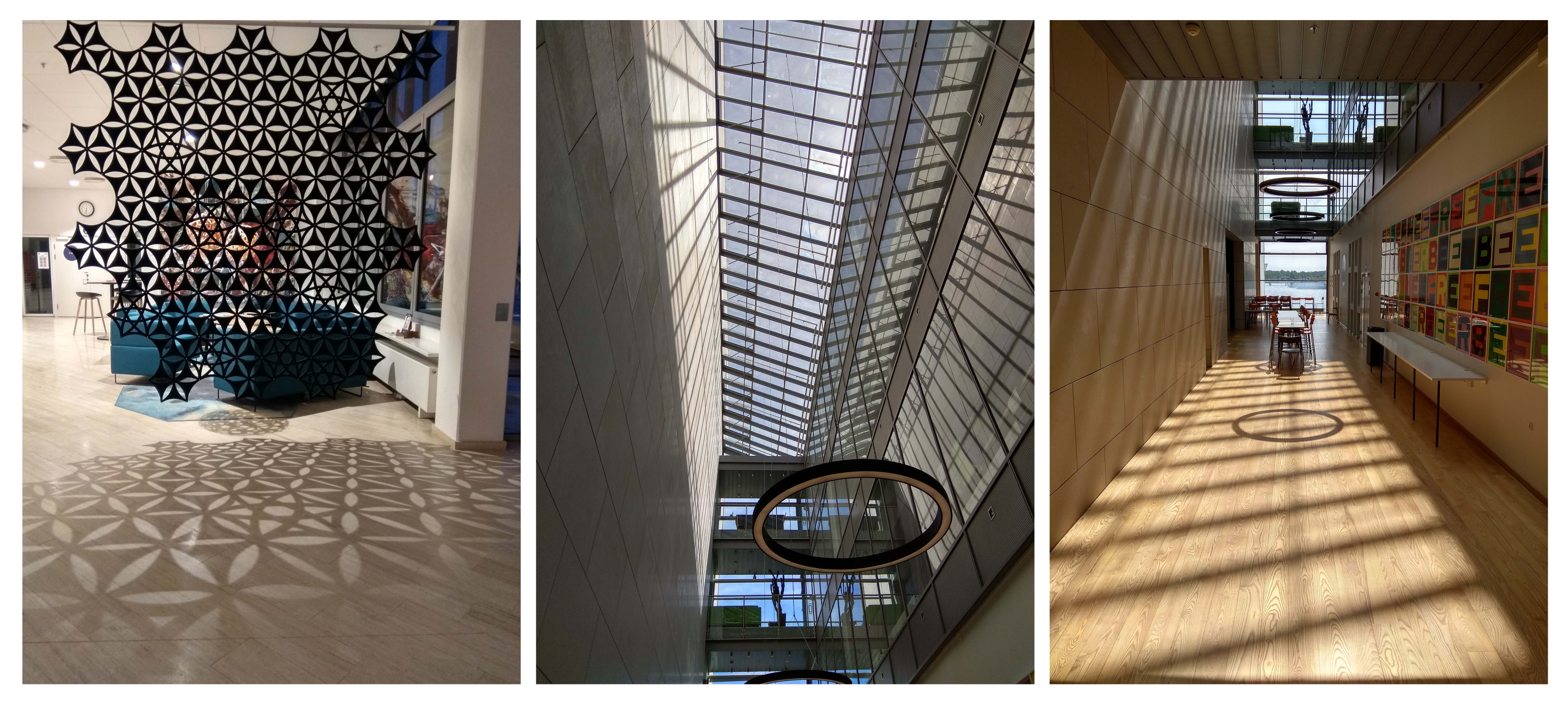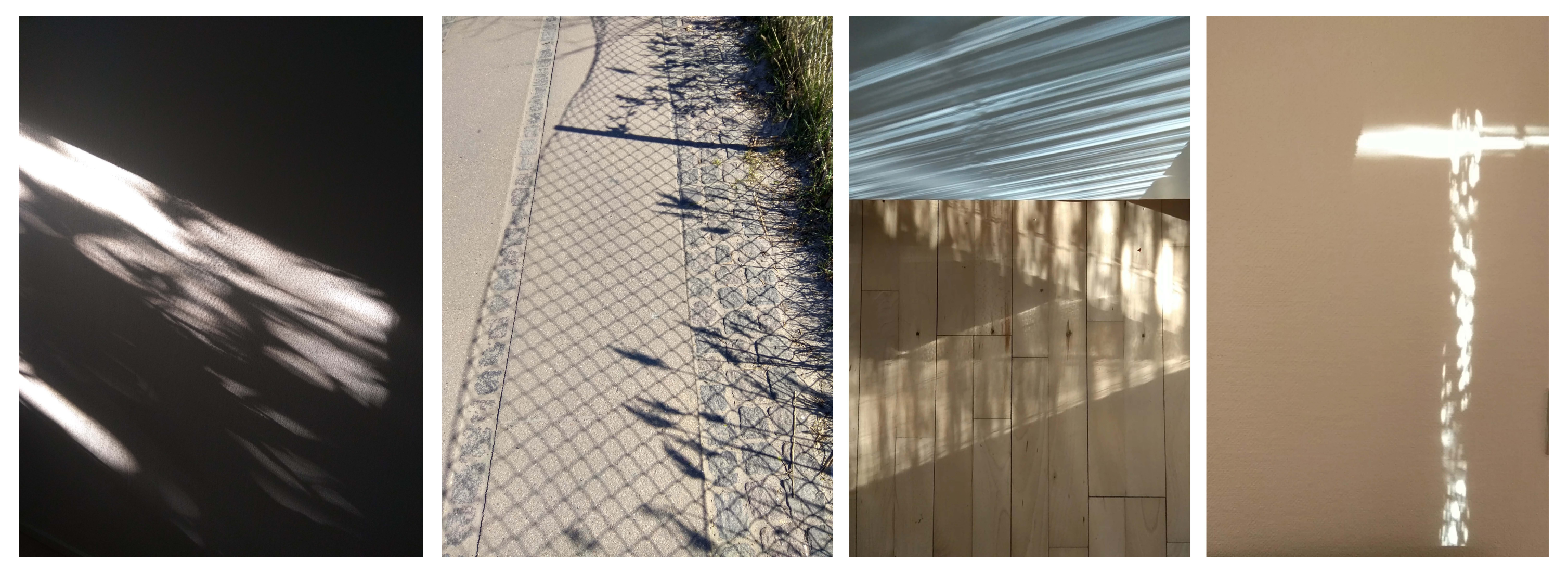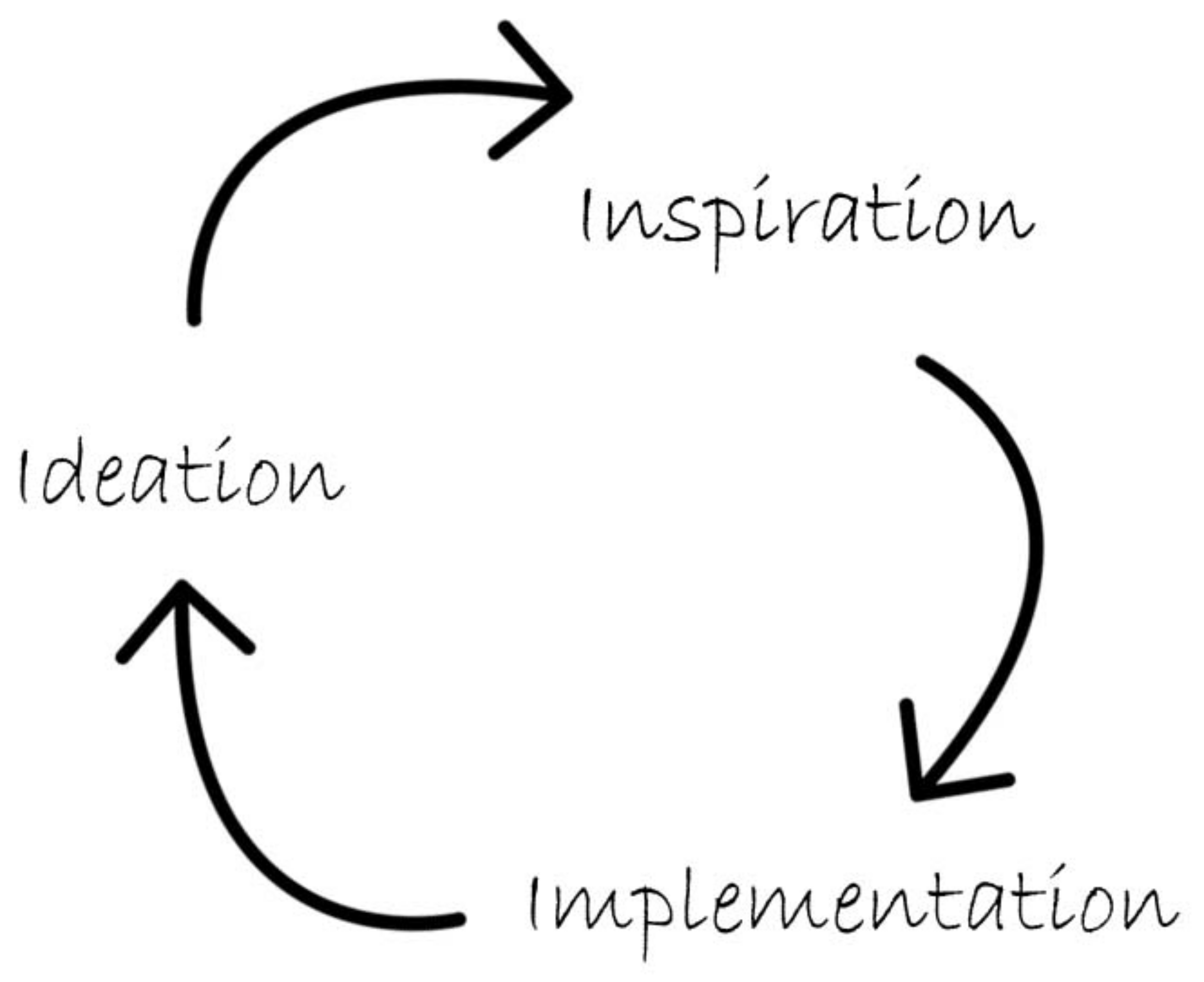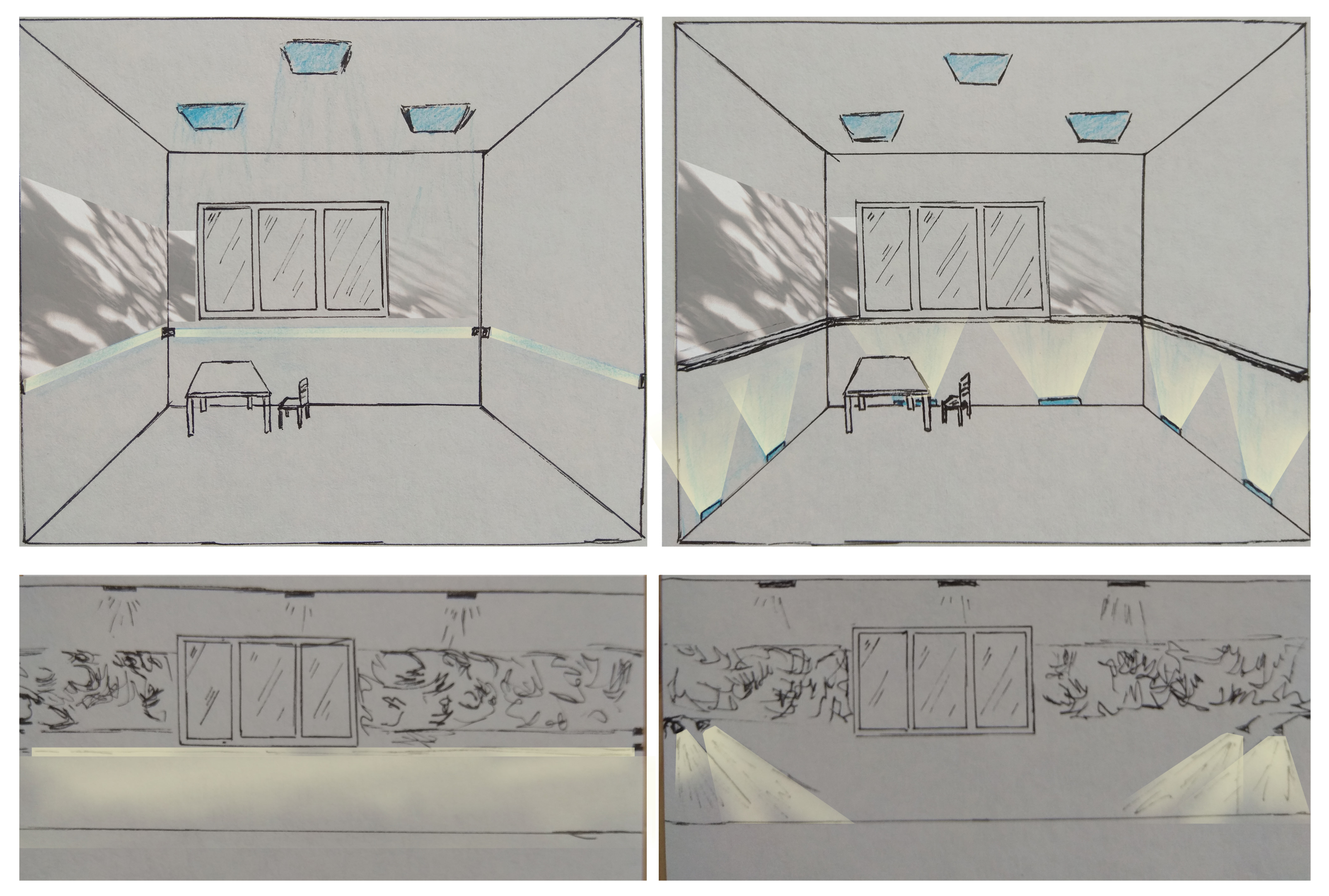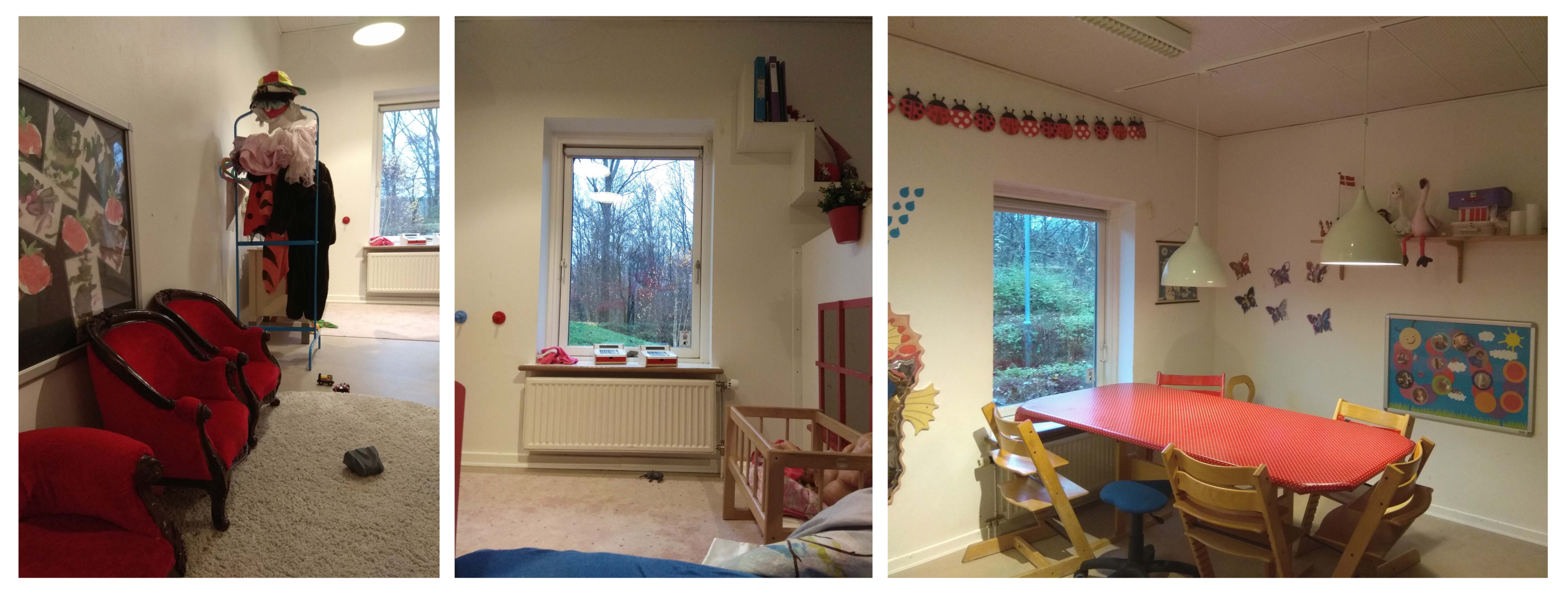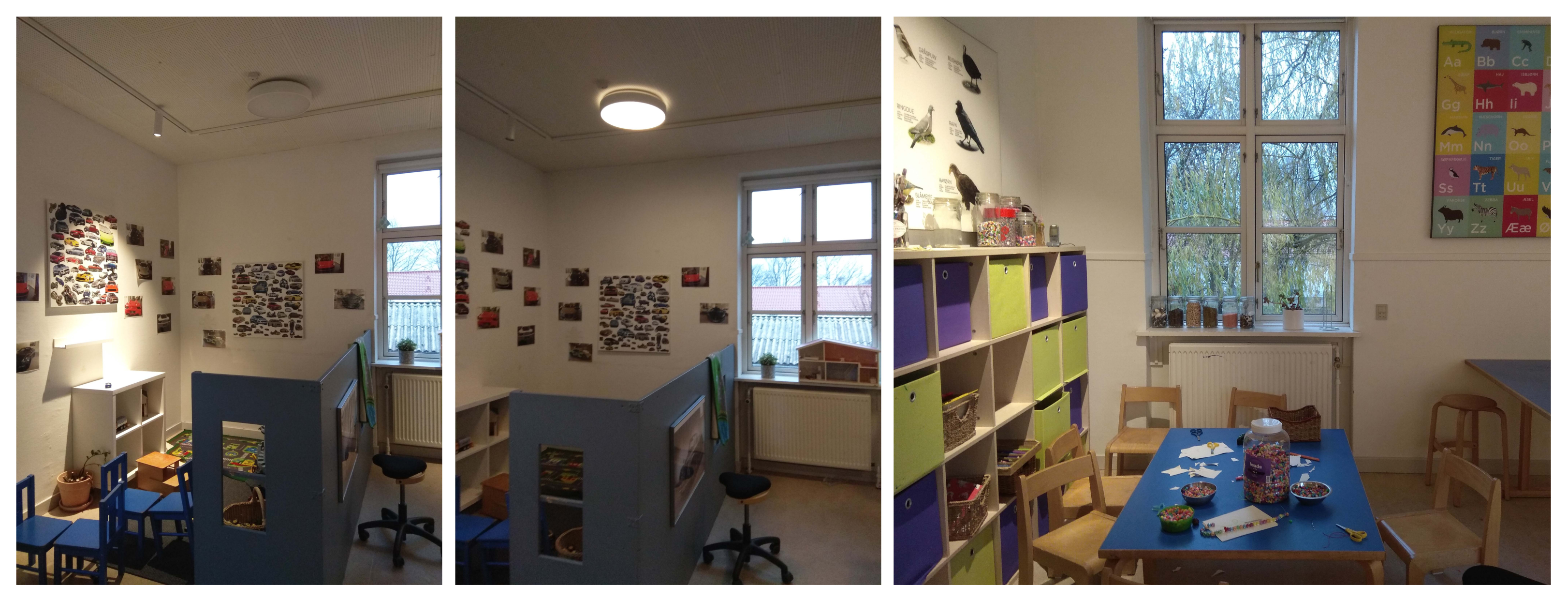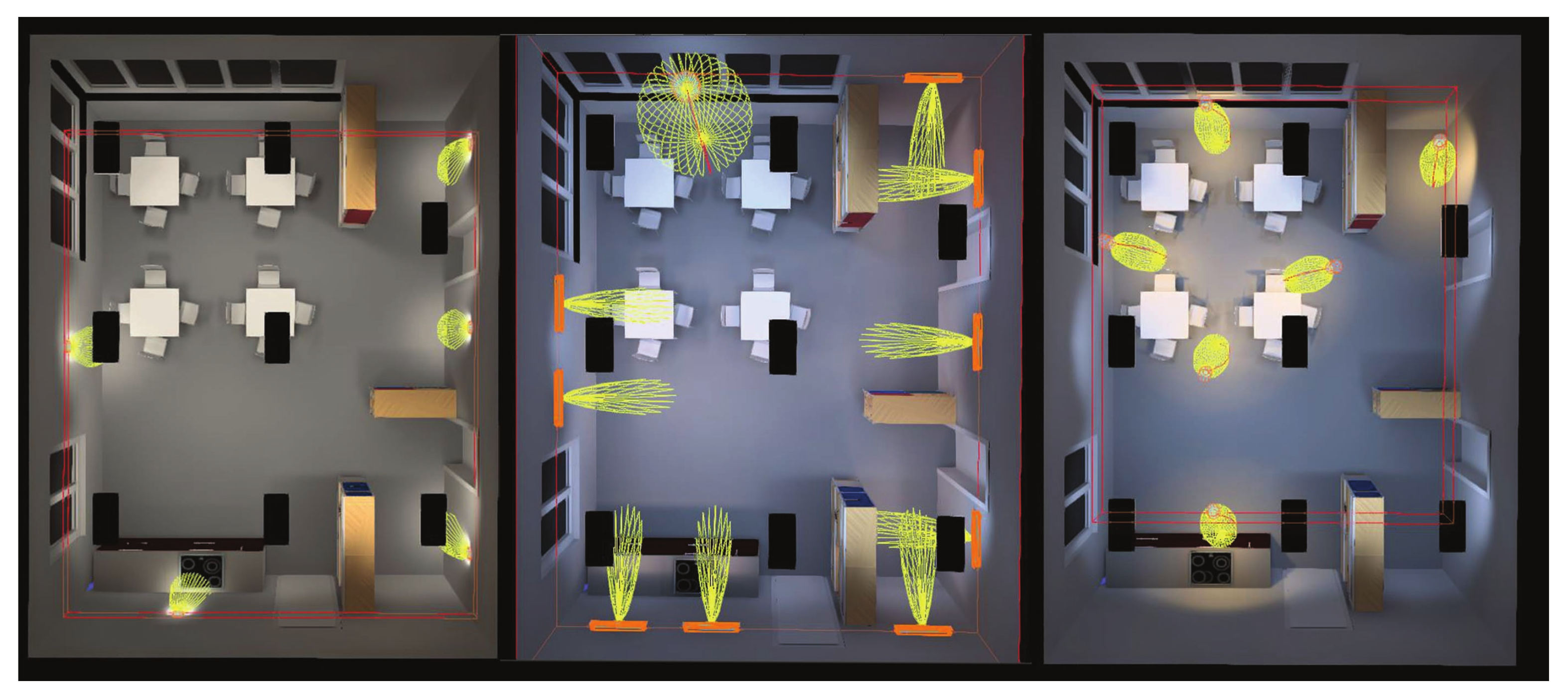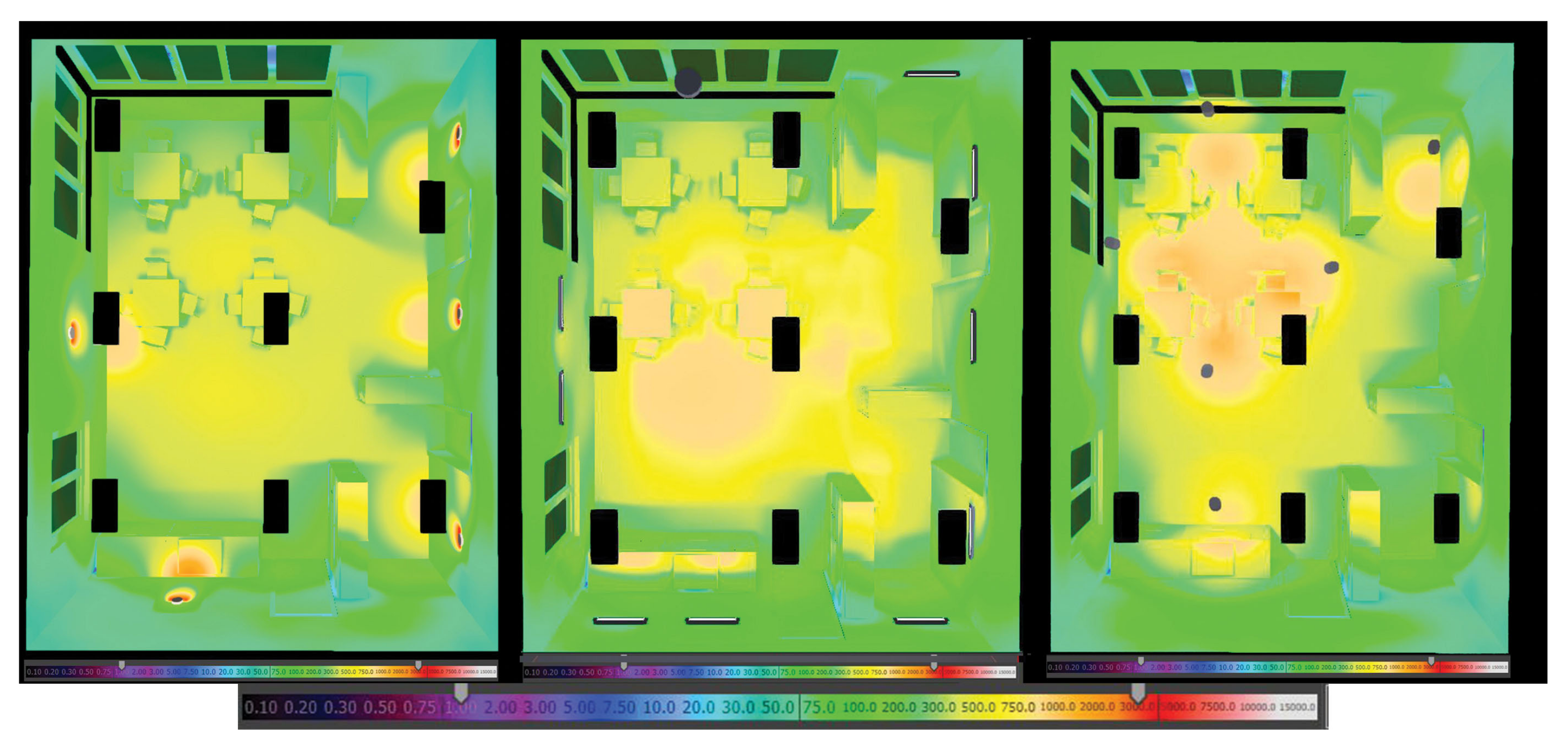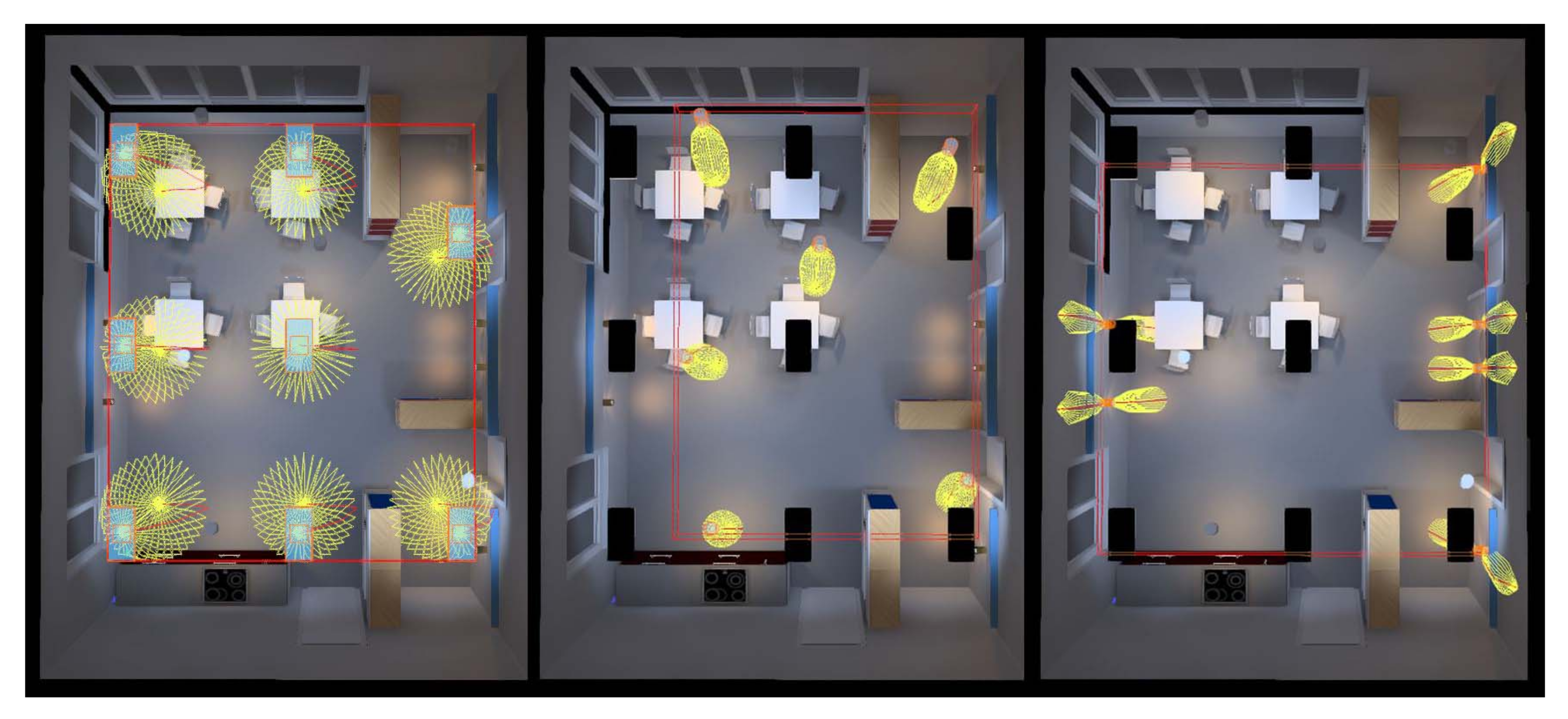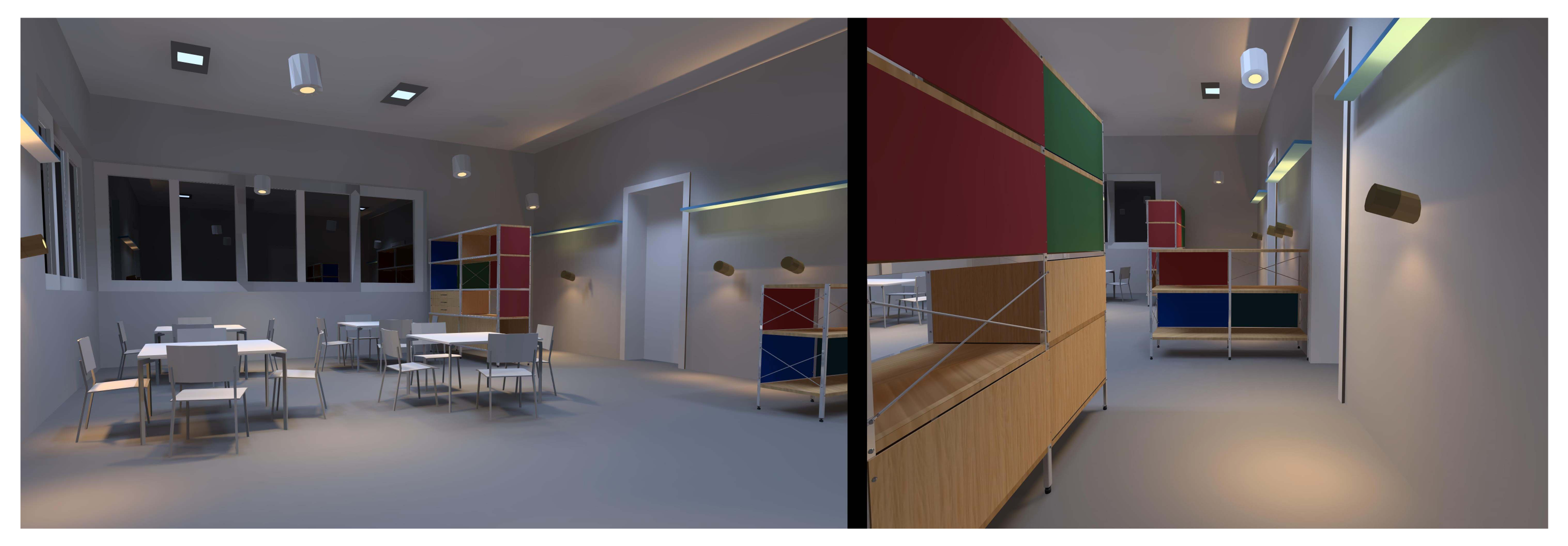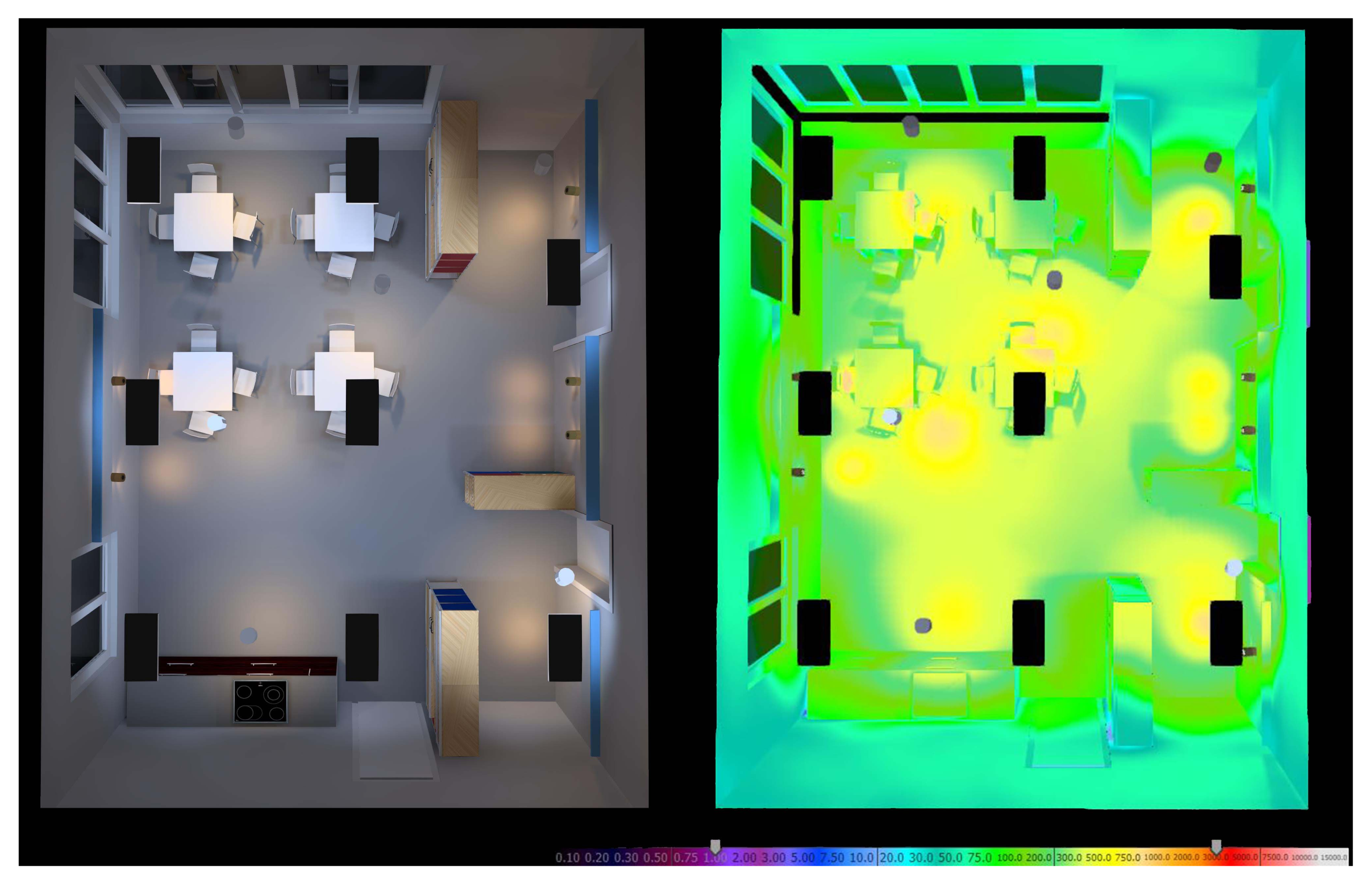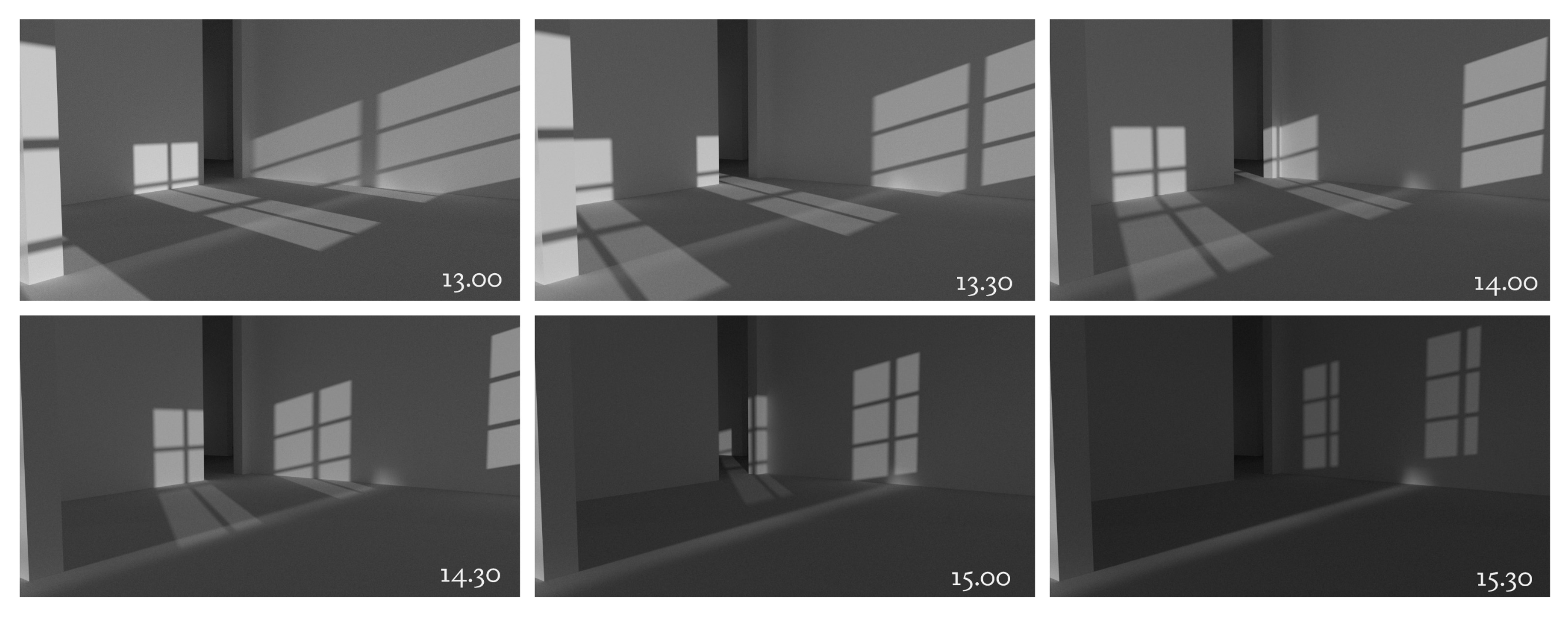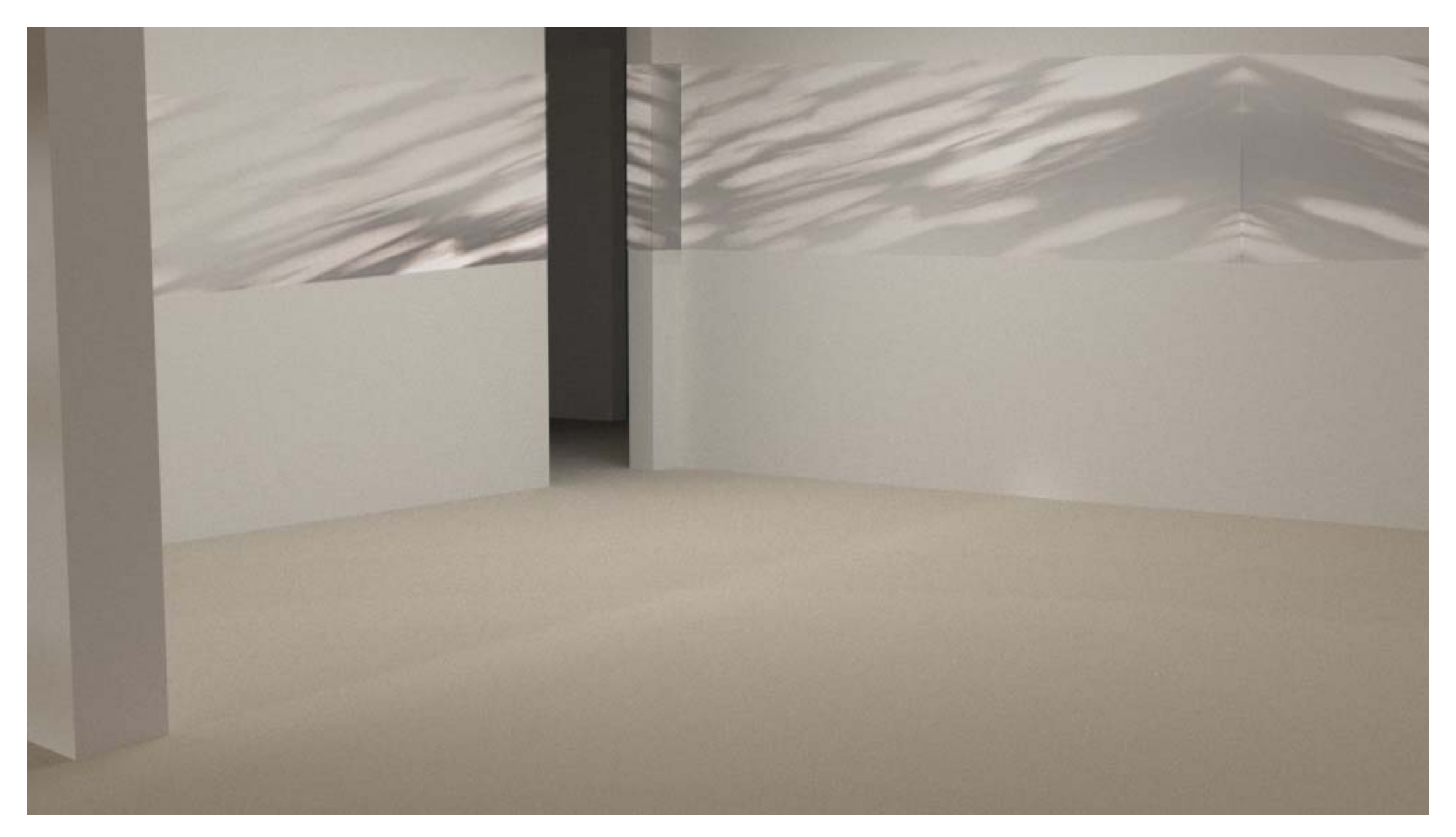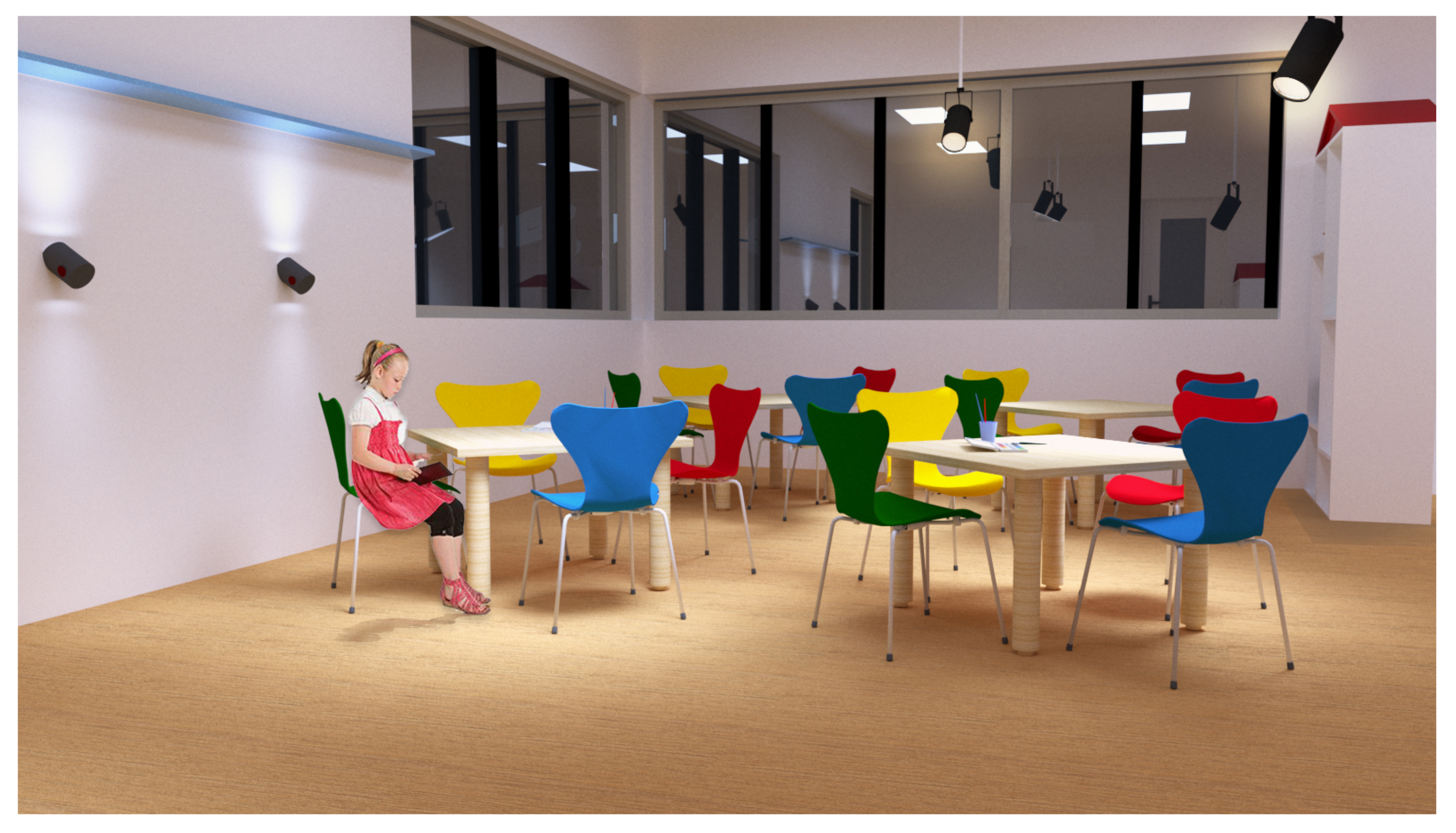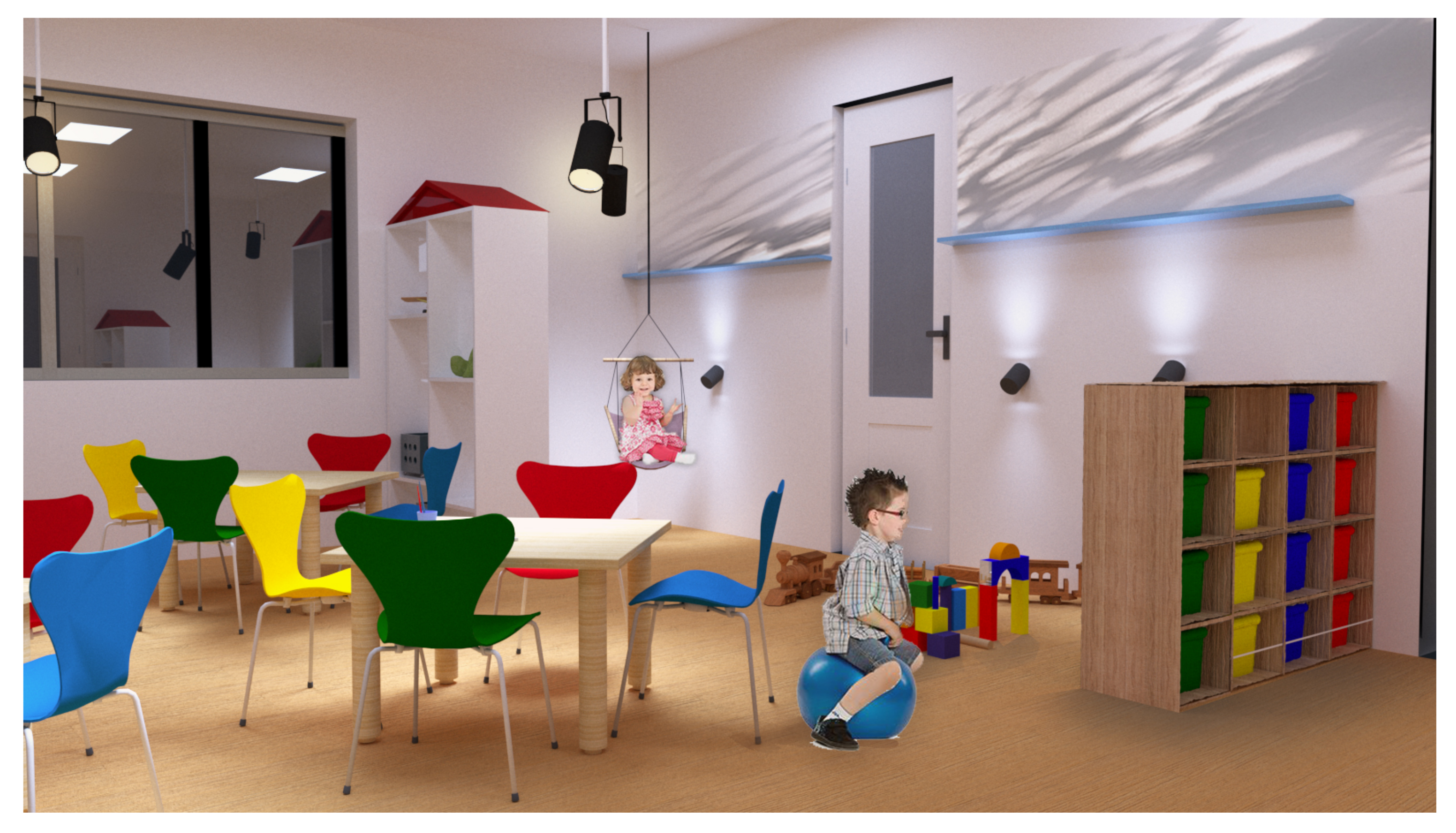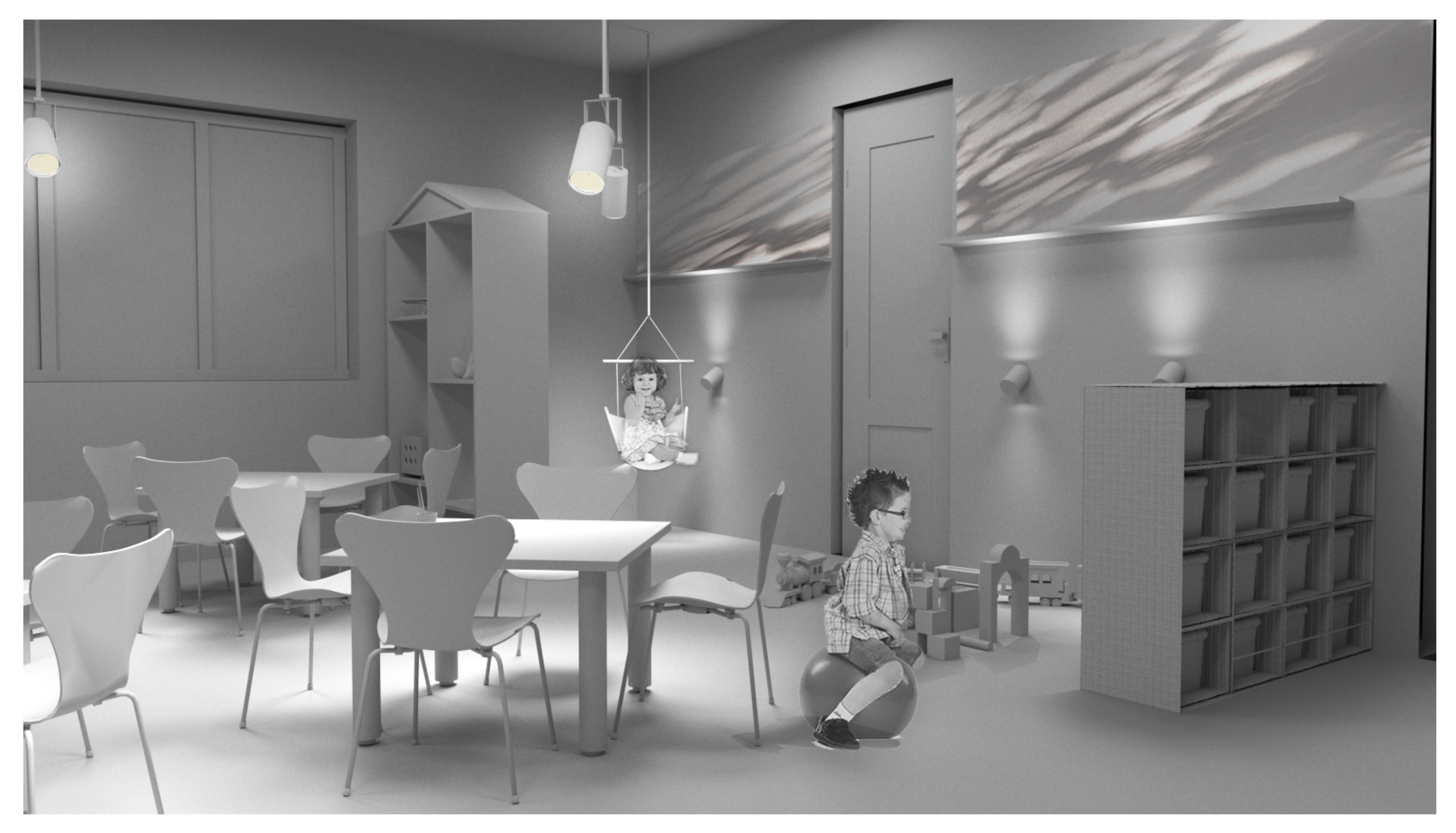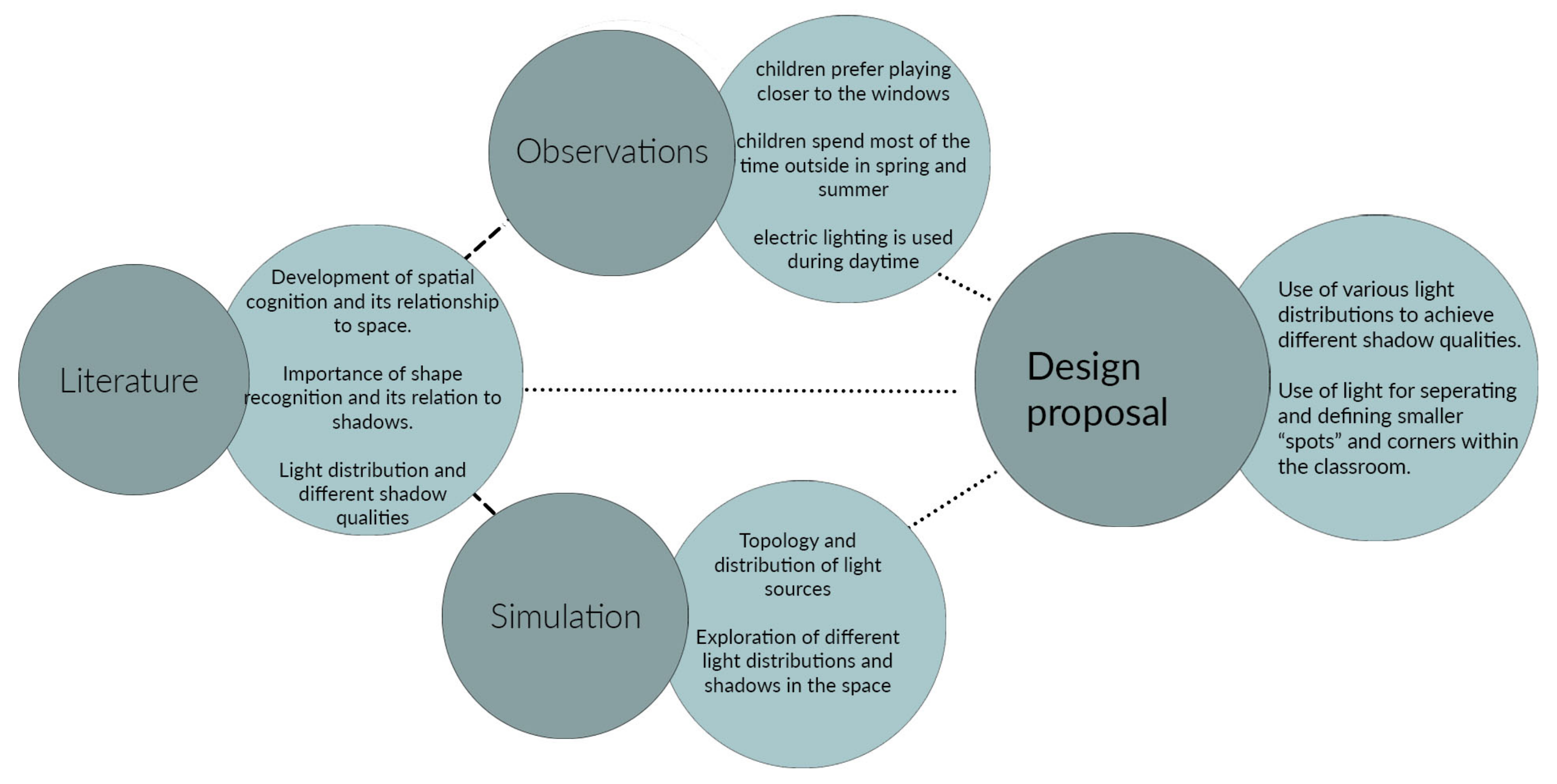1. Introduction
Light is a medium of spatial transformation, allowing a designer to reveal, enhance, highlight or hide specific elements of space [
1]. Light is a design tool linked to the ability of vision and the process of visual perception. The light that hits the elements in space to subsequently arrive at the user’s eyes enables and initiates the process of seeing. Seeing and perceiving are two different, though interconnected notions [
2].
This paper presents a study that aimed to investigate the importance of differences in vantage point on the perception of space and light. The observer’s height is the primary and most essential reference when observing the surroundings, since the change in height and therefore viewpoint throughout one’s life affects the perceptual process. Specifically, the described study focuses on the way children (as opposed to adults) perceive space and light in kindergartens from a different viewing height and perspective.
Since shadows affect the perception of an object’s size and form, they are fundamental for the development of children’s experiential repertoire and spatial cognition [
3]. Therefore, light and shadow became the focus of our investigation, and both real-world observations and software simulations were used to explore these two elements related to lighting in kindergartens.
2. Process Summary and Objectives
In order to introduce lighting design strategies, first, our project aimed to explore and investigate the following question:
How can visual perception be influenced by human height?
This topic was divided and structured into concepts from several contributing fields. We looked at visual perception science and how the anatomy of the human eye influences the perceptual process as well as into concepts of spatial cognition, anthropometry and ergonomics. These topics provided a foundation to inform the design of spaces that support cognitive processes of the users, focusing on the role of light and lighting. We also reviewed the existing lighting standards and guidelines and consulted the current research in the field of lighting and educational spaces. The described theoretical foundation of this study is depicted in
Figure 1.
The Process
The process model depicts the main points that were reviewed from each topic in order to form the question that we investigated. From the domains of perception and ocular physiology, our main topic is the physiological difference in the eyes of a child compared to an adult resulting in differences in depth perception. Infants can only perceive visual stimuli that are relatively close to them, which leads to attention and focus on detail. Regarding spatial cognition and ergonomics, there is a larger number of movements that a child has to perform in comparison to an adult to perceive a space fully and to observe an “out-of-scale“ room.
Additionally, developing spatial cognition in children, especially during the sensory-motor phase, is based upon haptic perception and experiences made relating touch and vision, indicating the necessity of well-lit surroundings for adequate form and size perception of an element. The focus on detail and the amount of visual information needed to be acquired requires sharp shadows and the use of contrast as a form of differentiation. Research on spaces designed for children suggests the implementation of scale as a concept and starting point in the formation of interior spaces.
3. Question Relevant for Lighting Design and Related Criteria
The background research, summarised below, led us to pose a design-related question along with the development of specific criteria for a lighting design strategy targeted to support children in a kindergarten environment.
The project focuses on the perception of light and space by children, with the goal to develop strategies to create environments that actively support perception from a child’s perspective through the use of light.
What design strategies for kindergarten lighting can support the perception and use of spatial environments by small children?
This research question emphasises the importance of a relationship between human scale, perception and orientation in space. It focuses on kindergartens, as these spaces are targeted to cater to small children (while remaining usable for the adult caretakers). One idea is to use light to perceptually scale down space to create an impression that fits closer with the scale of children’s perception, while keeping the overall physical scale of the general environment to also work for adults summarized below (
Figure 2).
Based on the background research summarised below, we defined some objectives to be met when designing lighting for kindergarten spaces.
Enhancement of the relationship between the space and children’s scale and vantage point.
Focus on children’s spatial perception.
Enhancement of spatial cognition through form and size recognition.
To achieve the above-mentioned criteria the following steps are necessary (based on research on spatial cognition, shadow and scale).
Bringing the light closer to children.
Create a new distance between the light sources and the space used by the children (plane of movement and plane of activity).
Take advantage of the concept of light-dark or colour contrasts in distinguishing the different uses and forms in space (see also section on spatial cognition).
Use light sources that create sharp and defined shadows, and therefore show clearly the relationship between the scale of the shadow and the actual objects found in classrooms, in order to support the development of perceiving form and shape.
The optical division of space into smaller parts provides the opportunity for different uses and activities. This division will create new spatial relationships.
4. Literature Background
4.1. Visual Perception
Visual perception is the process of recording and analysing multiple visual stimuli and data. It is performed on a continuous and often subconscious basis [
1]. The amount of received information is higher than the amount that humans realise and acknowledge, as it would require dedicated and obscuring focus to consciously analyse every single stimulus.
Perception incorporates all five senses, although vision is considered the most dominant. Visual perception uses the visual principles of balance and order, as those elements are easily recognised in a space. Seeing is apprehending specific details from the visual stimuli and further processing them through the perceptual system [
3].
“The body is our general medium for having a world.”
Merleau-Ponty, 1962, p. 169 [
4]
Here, however, Merleau-Ponty emphasizes the importance of realising that perception is acquired through our whole body, and therefore, all our senses [
4] The perceptual and cognitive sciences are closely linked with biology and medical sciences (e.g., the eye’s and brain’s physiology and anatomy), psychophysics, philosophy and the phenomenological approach of perception. In addition, the art and design fields actively experiment with both the capabilities and limitations of human perception.
4.1.1. The States of Perception According to William Lam
The overall process of visual perception aims at sorting the total amount of information into the part that the individual needs to analyse to understand their surroundings, and the part that will be moved to the unconscious [
5]. There are three main stages in the process of visual perception to profoundly understand a visual stimulus, as described by Lam [
1]: the attributive, the expectant and the affective stage. The attributive component is responsible for relating the current visual stimulus to previous experiences and memories. The following component, which is the expectant, regulates the viewer’s expectations based on their memory, and the affective is responsible for their emotional response to the stimulus.
4.1.2. Light and Perception
The perception of light depends on not only the physiological aspect of seeing but also on the physical parameters connected with experiencing the surrounding environment. In order to perceive light, there also needs to be darkness as contrast, making these two concepts interdependent. The coexistence of these two states in space permits the perception of spatial dimensions, patterns and shapes. Visual perception is initiated by the eye’s structure, and three different types of photo-receptors, rods, cones and intrinsically photosensitive retinal ganglion cells (ipRGCs) that are located in the retina of the eye. There are three different types of cones, which enable the perception of colour and operate under high light levels. Rods are sensitive to lower light levels and do not provide information about colours [
5].
Although light is mainly associated with visual perception, there has also been research regarding the non-visual effects of light mediated mainly by the ipRGC photoreceptors. Research has revealed that these receptors are linked to the regulation of body cycles, such as the circadian rhythm [
6]. Additionally, there is research of the human body to sense light without vision. This research argues that light might be perceived through the skin evoking bodily sensation as part of an ambient atmosphere that exists in space, asserting that skin is the medium through which one can perceive light without seeing it [
7]. The sensation of atmosphere as described by Böhme is an inseparable part of space and its perception [
8].
“The character of an atmosphere is the way in which it communicates a feeling to us as participating subjects.”
Furthermore, the perception of light is related to the perception of colour and form [
10]
4.2. Ocular Physiology
The physiology of the eye is continuously changing in the first years of human life. From the moment the eyes begin to form in the fetus until the first three years of the child’s age, the physiology of the eye is developing. The way children see and perceive their surroundings is not the same as adults. Most babies are hyperoptic when born, which means that they perceive their distant surroundings as a blurred image and can only see detailed objects and figures from a short distance. Additionally, an infant’s cornea is flatter compared to an adult’s, which further results in alterations on how infants perceive depth information as their field of view is different.
The size of the cornea increases and, by the age of two, it is similar to those of adults. The increase in the cornea size results in higher accommodative power. The lack of accommodation speed results often in infants reacting to bright lights and higher intensities by closing their eyes, a sign of probable annoyance [
11].
4.3. Spatial Cognition: Adults and Children
Spatial perception is primarily based on vision when it comes to adults, although the process of analysing space is multisensory as it incorporates the use of all senses [
12]. Research has shown that spatial intelligence is a trait that evolved in relation to the surrounding environment. The environment one grows up in defines what is perceived as familiar. The evolution of spatial intelligence is also adaptive, which results in the differentiation of spatial analysis and perception based on the surroundings [
13].
Scale is an essential factor in spatial perception. Spatial scale and the height and viewpoint of the observer are crucial regarding the way the individual perceives their surroundings. This is relevant, because wide or narrow and high or low spaces have a different impact on the emotional state of the viewer as well as provide a different amount of acquired spatial information [
14]. The observer’s height also contributes to the way someone perceives the size of space.
According to Neufert, the human scale affects the first impression of a space, since the size of a specific room is determined by how many movements one needs to perform to extract the total amount of visual information needed for the first impression of this room [
15]. The amount of head movements needed is determined by the field of view of the human eye. For instance, in cases where the room is above 3.5 m high, an average person needs to perform more than one head movement to perceive the dimensions of the room.
The same principle can be applied to the way children perceive the same space. The human, in this case, is smaller, and children therefore need more movements than an adult to perceive and assess the same space. However, the spaces used by children are usually designed based on the size of an average adult. Moreover, children base their perception and orientation on landmarks in space or fragments of space that act as landmarks, following a navigational strategy to move in a particular area [
13,
16].
Spatial cognition in children is important to be developed and supported early on. Based on Piaget, there are four different stages describing the development of cognition in children [
17]. The first one is the sensory-motor stage, which covers the first two years of age and includes the use of movements and senses as it is primarily based on haptic perception. The second stage is the preoperational stage, covering the ages between two and seven years old, where the child starts thinking symbolically, but his perception is still egocentric.
The third stage is called the concrete operational stage and is up to 11 years of age. At this stage, the child begins to think logically and starts considering how other people feel and think. The last stage, as described by Piaget, is the formal operational stage, which usually starts at the age of 12 and onward. During this stage, the child starts reasoning and analysing moral and social issues [
18].
The notion of space and spatial cognition is fundamental during these stages. The way children perceive space is also linked to their height. During the first two stages, vision is not the dominant sense used to perceive the environment, as it follows the sense of touch [
19]. A child explores new spaces mainly by touching the unknown elements. Even infants not able to walk, when they are in a new area do not stand still but look around and perform instinctive moves to explore the space. As stated by Piaget, haptic perception is dominant during the sensory-motor and preoperational stages as the child perceives the surroundings based on an egocentric way of thinking. Space is defined based on the elements that can be reached by the child and therefore based on the child’s own size. The elements that are closer to the child are the ones first explored.
4.4. Anthropometry and Ergonomics
Anthropometry is a branch of the human sciences that is many centuries old. Written evidence dates back to Vitruvius, including calculations of the human body, and it is linked to architecture as a form of framing spaces. Anthropometry is the attempt to define the amount of space needed for performing specific movements and actions. Durer was the first to write a book based on the lengths of heads, faces and feet to cover the variety of body types and sizes [
20]. Anthropometry is crucial as it creates a frame in which the designer can work. It includes detailed measurements of the human body along with calculations of basic movements a person performs in space. Anthropometry provides a foundation to design a space based on the human-scale.
Ergonomics is a scientific discipline that concerns itself with the impact of environmental factors on the human physical body to promote safety and well-being, for example in workspaces. Ergonomic design is based on the principle of user-centred design and therefore the domain of anthropometrics.
Research regarding ergonomic design in classrooms has shown that the use of non-ergonomically designed furniture results in the wrong posture and back and leg pains as reported by students [
21,
22,
23]. The lack of size variety in desks and chairs creates a mismatch between students and school equipment. Ergonomically designed furniture and elements in space are a fundamental factor defining the use and effectiveness of the performed activities and long-term support of the users’ physiology.
4.5. Spatial Relationships
The dimensional relationships between a room’s height, width and depth affect the viewer’s emotional response towards space as stated by Neufert [
15] and Rudolf Arnheim, who mentioned that the principle of visual balance is dominant in the way the viewer perceives space, suggesting that the relationship between the dimensions of a room need to be in balance [
3].
Looking back into the way spaces and buildings they were referring to were designed, one can find the search for harmonious proportions, One example is the golden ratio deriving from mathematical formulas as a basis for design. The evolution of design incorporated human dimensions in the form of anthropometric measurements in the design process in order to create “human-scaled“ spaces [
15]. Another example, from the early 20th century, is the “Modulor“ system introduced by the well-known architect Le Corbusier [
24].
The concept deriving from the use of various dimensional relationships is the creation of a space that would be analogical to the human-scale to enhance spatial perception and cognition and result in a positive emotional response in the user.
4.6. Designing Spaces for Children
“Children had a formal sense of their school building as a rectangular block with which they had a physical relationship in terms of shape and scale.”
Recently, the process of designing spaces for children has acquired new parameters, to include and actively incorporate children’s spatial perception, which is fundamental both for the way space covers functional needs and results in mental satisfaction and pleasure. There is a new tendency by designers to acknowledge and incorporate the way space is perceived and seen through the eyes of a child. For example, children’s drawings have been used as inspiration for designing nursery schools. Additionally, the element of scale and variations in size have been taken into account in the design process [
26].
Following these tendencies, there is now a considerable number of kindergartens with design concepts that can be analysed in those terms. In many cases, forms and shapes were derived from sketches made by children, which is the reason there are house-shaped windows and elements representing the way children perceive and depict the notion of home in some nursery schools [
27]. House-shaped windows are specifically designed at the appropriate height based on the children’s scale to be used as benches, providing, at the same time, a view towards the outside environment and access to daylight [
28].
The element of light has also been found to be essential in designing spaces for children. In some cases, the windows are designed to offer the opportunity of interacting with light. In other cases, “light chimneys“ are used in order to draw an even larger amount of natural light in the interior space [
29]. In the Educational Centre En El Chaparral in Granada, designed by the architect Alejandro Muñoz Miranda, natural light was the core element around which the entire design concept unfolded [
30].
A variety of differently coloured filters has been used in the openings around the building to allow more natural light to come into the corridor. At the same time, the element of colour defines the particular use of an area. Coloured filters were placed in front of daylight openings in the corridors leading to (and marking) the areas where break time takes place, while the absence of filters defines the areas closer to the classrooms [
27].
4.6.1. Lighting in Educational Spaces
Lighting is also an essential attribute of the educational spaces, providing functionality and comfort, specifically when it is combined with daylight. Lighting, along with acoustics and temperature, are the fundamental environmental elements of a good natural condition in interior spaces [
31].
Recent tendencies to create multi-functional educational spaces provide the opportunity to support and use scenarios and different learning activities through lighting design. In many cases, large classrooms are used for various activities of the curriculum by having the ability to transform into multi-spaces. There are suggestions that the lighting design could support the variety of uses by being adjustable and controllable by the users [
32]. The lighting could also become a tool to highlight and signal specific activities or areas in space as needed. Additionally, the light itself could become an educational tool by creating a design, which allows the user, in this case the teacher, to change the light, and creates situations with either more diffused or directional light to support the activity [
32].
Apart from electrical light, which is necessary, daylight is considered of utmost importance in schools and kindergartens. Studies have shown that students perform better in classrooms with more daylight compared to classrooms with less daylight, and classrooms with large window areas are preferred compared to classrooms with skylights and small operable windows [
25]. Additionally, increased daylight intake is linked to the amelioration of perception of visual stimulus, mentality and higher performance [
33]. The amount of natural light in interior spaces is primarily linked to the orientation of the building, the geographic location, type of windows and the change in seasons.
4.6.2. Lighting Standards
Lighting design is a vital aspect in designing educational spaces, and specific requirements need to be met. The amount of light needed varies depending on the type of space and its intended function. Generally, in educational spaces and classrooms, the amount of light needed has a great variety due to the numerous different course activities that take place throughout the day. Specifically, lighting standards as shown in
Figure 3, the requirements in kindergartens are set by the EN 12464-1:2011 lighting standards [
34].
Based on this given standard, the illumination in nursery and playrooms of kindergartens should be above 300 lux with a light uniformity of 0.40. In the same document, the reflectance values of the room surfaces are also recommended. The ceiling reflectance factors vary from 0.7 to 0.9; for the walls, they vary from 0.5 to 0.8; and for the floor, the recommended values are from 0.2 to 0.4.
4.7. The Human-Scale Factor
“With our own sense of scale and proportion, adults experience places of childhood, including our former schools, as much smaller in size than our memories tell us.”
Human-scale is essential and defines the way one perceives the surroundings. The reason space might feel small, huge or cosy is due to the perceptual and emotional response the user has towards the space. The created proportions between a user and the space are defined by the user’s viewpoint. Introducing and accounting for the way children experience space, one obvious aspect to take into consideration is the difference in scale and vantage point. A child and an adult perceive the same elements in space from a different point of view, and therefore perceive it in a different way.
The following photo (
Figure 4) depict the same scene with the same focal point, and the only difference is the height of the viewpoint. In the first photo, the height is 1.10 m while in the second one, the height is 1.70 m. There is a distinct difference regarding the shadow, related to the user’s point of view.
The difference in height causes different visual information at eye-level when the viewpoint is at 1.10 m compared to at 1.70 m height. The visual field of a child is at a lower level, and therefore the immediate surroundings are perceived differently.
The perceptual difference between children and adults is also connected to the fact that haptic perception is dominant in children, meaning that spatial cognition is based on the sense of touch and discrimination of the various elements in space that are within a child’s grasp. Children tend to approach the elements of their immediate surroundings based on their scale, and therefore the elements of shadow and contrast are significant as they help define the form and size of these elements and contribute to building a repertoire of spatial experiences.
4.8. Shadow and Scale
Shadow is the result of light in space. Darkness and light coexist in space and complement each other [
35]. The element of shadow helps the viewer perceive spatial relationships, such as distance and size when comparing two objects. The size and density of the shadow provide the viewer with information to assess the scale of the objects in the room along with the distance between them. Shadows can also be a useful tool for enhancing an existing atmosphere [
36].
Although the element of shadow can be linked to multiple spatial qualities, for our purposes described here, it will be used in relation to the perceived scale of a space. The scale of the shadow depends on the characteristics of the light source as well as on the point of view.
In the following example, as shown in
Figure 5, the scale of the shadow is not necessarily related to the size of the object. In the first illustration, the shadow is distorted, giving an altered impression of the object creating it. The light is not directional, and the shadows reveal different shades (as the shadow seems sharper closer to the object) and have a gradient as the viewer moves further away. In the second and third illustrations, the shadows are created from the roof of the building. The sunlight is the source of light that creates these shadows, and the only difference is the time of the day and therefore the direction of the sun’s rays. In the second photo, the relation between the scale of the shadow and the object’s scale is harmonious. In the third photo, the shadow on the floor seems to belong to an immense element dominating the space.
The size and form are essential characteristics of shadows and information which derive from the viewer’s understanding of a shadow and its relationship with the object casting it. It is essential to be able to comprehend how the object may look. The scale of the shadows can define the form and texture of the object and therefore its appearance [
37].
Daylight and Shadow
Shadows are a unique mixture of light and darkness. Light and shadow are essential and interrelated, having fundamentally shaped our experience of space and time. Traditionally, time orientation is learned and performed through the observations of daylight and shadow in the natural environment [
38]. The enhancement of time orientation can be useful to incorporate into lighting design to connect people to nature’s light-dark rhythms, especially as, currently, people spend most of their day in interior spaces. Time orientation is linked to the human’s contact with daylight and sunlight, and therefore windows act as a medium of letting daylight into interior spaces and offer an opportunity of contact with the exterior environment and the time of day.
A merging of interior and exterior spaces is achieved by light and patterns created both in the interior and exterior space [
39]. Both natural and artificial light patterns act as an indicator of the existence of daylight and sunlight. Natural patterns created by trees or another form of vegetation in interior spaces can introduce a connection to nature in the interior space.
Light and shadow patterns can sometimes also be linked with specific hours of the day. The last two photos (
Figure 6) of light patterns only appear during the morning (due to the direction of the morning sun) and therefore suggest information regarding time.
5. Methods
Based on the literature review, we planned a design exploration that adopted a multi-dimensional approach based on design thinking, as outlined below, and was also informed by site observations and software simulations. Our objective was to gain a better understanding from both a theoretical and practical point of view of how lighting design could better support children in kindergartens. Using these techniques allowed for the development of a proposed strategy, which incorporates prior experience from practice and research, the current situation in kindergartens, new definitions of the users’ needs, along with the experience in the field of lighting. The following paragraphs present the techniques adopted for this design exploration.
5.1. Design Thinking
Design thinking is a human-centred approach implemented during research and innovation projects in various domains with the aim to create a fertile environment to discuss and solve design-related questions and problems [
40]. Research-based projects require the definition of a specific topic derived from an interest or a concern [
41]. Principles of design thinking lead to the investigation, testing and prototyping of proposals.
The focus during this process is catering to humans and their needs. Through the design thinking process, one can blend different projects and fields of interest. The collaboration of multiple sectors in research and application is a key principle for this process to succeed [
42].
The three principles of the design thinking workflow are: inspiration, ideation and implementation. At the beginning of a project, the human factor “expressed as the defined users’ needs and experiences” is fundamental for the project definition. The following ideation phase includes integrative thinking and leads to the experimentation phase, where various solutions are tested and where points of view by collaborators from different domains (from technical to sociological) are shared. The design–thinking cycle (
Figure 7) depicts the core idea of design thinking. It shows that any solution or result is still part of a process and not final and that it can be constantly re-evaluated and refined through further testing [
40].
5.2. Observations and Simulation
Observations of two different kindergartens, documented with photographs, along with two semi-structured interviews with one teacher in each kindergarten were conducted to better understand the use of the space, the current lighting situation and to inform any potential alterations. These observations are described further below; they provided a foundation for the proposed design strategies.
In order to test different light distributions and calculate the light levels for different scenarios, simulations were conducted using the software Dialux and information about a selection of light fixtures from the Dialux library. The simulation tests contributed to the proposed strategies, as described further below.
6. Concept
The above-presented background led to the development of a proposed strategy for lighting in kindergartens. The objective was to re-think the kindergarten classroom in order to create an environment that will cater better to the children’s scale, perception and spatial cognition using the concept of viewpoint and shadow and their impact on children’s space perception.
In order to achieve the desired shadow qualities it became necessary to bring the light closer to the children by creating a new distance between them and the light sources. The new distance also affects the general level of illumination of the space in addition to creating different shadow qualities.
The proposed lighting concept also includes the element of contrast in order to better separate areas that have different uses. Such a division of space into smaller parts could be based on the daily curriculum and the activities. In the following sketches, the implementation of the proposed design strategies is illustrated and explained.
Sketches
A lighting design for a kindergarten classroom is proposed to have three layers as illustrated in
Figure 8. Ceiling lighting provides general ambient illumination in the space and supports overview and practicality. However, the second layer is proposed to create a second light ceiling by using lights at a lower height that focus on illuminating specific parts of the walls to create an impression of a space that is lower and closer to the children’s height. The lights are brought closer to the children to create the impression that the ceiling is at a lower level. The height should be adjusted to the average height of the children in each case [
43].
The proposed third layer introduces a natural pattern, for example using projections or reflections, at a height above 1.70 m to introduce nature-inspired elements inside, merging the exterior environment with the interior space. The patterns are proposed to change at different times of day to enhance the time orientation and provide a connection with daylight. The use of different patterns can also be coordinated with different activities of the curriculum or can vary and provide signals depending on the month and season of the year.
7. Observations
Our site observations regarding current kindergarten lighting situations were made in two facilities in Roskilde, Denmark. The visits took place in winter, on the 22 of November. The lighting scenarios in the two kindergartens were different. Photo registration and semi-structured interviews with two of the teachers were the tools used for gathering information. During documentation, the camera settings were kept the same for all photographs.
The opening hours were the same for both kindergartens as their daily schedule started at 9:00 in the morning and ended at 19:00 in the evening. At 11:00 a.m., according to the curriculum, it was lunchtime and at approximately 11.30–12.00, it was nap time. The nap length was not specific, as the educators stated that they do not wake up the kids. The first visit was performed in a kindergarten where infants from six months old until three years old are accepted. In the second visit, a space that is used by toddlers from three to five years old was investigated.
In both cases, electric light was used during daytime to supplement daylight, especially in autumn and winter. During the same seasons, the kids spent most of the time inside the classroom, performing various activities in the same space. During spring and summer, the electric light was not widely used as the kids spent most of the time playing outside, apart from lunch and nap time, when the classroom was used. There were windows in all classrooms, although the orientation of some classrooms did not allow the same amount of daylight intake.
Blinds were installed in all openings and were mainly used during nap time. The windows were also used as areas of exploration as the children could sit and observe the exterior. The teachers stated that children prefer playing closer to the windows. In both cases, the teachers supported that the daylight was not sufficient, sometimes even during the summer months, and electrical lighting was used to supplement.
The lighting used in the first kindergarten was a combination of spotlights and pendants. The pendants were placed above certain areas and elements, such as the lunch table as shown in
Figure 9. The pendants and the spotlights were not dimmable, and the colour temperature of the light could not be changed. According to the teachers, the option of dimming the lights would be helpful during specific activities where not all lights are required.
The second set of photos (
Figure 10) were taken in kindergarten 2 where new lighting had recently been installed. This was a combination of ceiling lights that gave ambient light and spotlights. The spotlights could be adjusted, moved and dimmed. In this case, the kids were also allowed to change the light themselves, and it was stated that during the day, they either asked or changed the light based on their preference. The use of spotlights divided the classroom into smaller areas, which were used for different functions. In the first photo, only the spotlights were used, while in the second, the ceiling lighting was on. The spotlights faced the walls, decreasing the amount of glare as stated by the teachers; for that reason, they were preferred over the ceiling lights.
8. Simulations
To test design ideas, simulations were set up. For these simulations, a standard floor plan of a nursery school designed by Franken/Kreft Architects, from Neufert’s third edition book,
“Architect’s data“ was used [
15]. The digital model was created with a minimum amount of objects as the focus was investigating the difference in distribution and the resulting shadows. The aim was to create a lower, visual ceiling using light to perceptually scale down the space and to introduce sharp shadows and contrasts.
Three different scenes were produced and compared, simulating market-available lighting products that were placed at the same height in the virtual space. The ceiling lights that were used for ambient illumination were set to a correlated colour temperature of 4000 K (neutral white appearance) and were used in all three scenes. The variable for the three different scenes was the light distribution. Some lights were placed in the periphery of the space, close to the wall at 1.70 m height, to achieve a higher light level from this height downwards and create a contrast compared to the upper part of the room, which was kept darker.
As illustrated in
Figure 11, the first option had downward lights placed along the walls. The light distribution created higher light levels immediately around the light fixture. In the second option, the distribution of light was wide, and the light diffused in space. In the last option, spotlights were used with a narrow angle distribution. The light hit the objects of the room, creating smaller areas of concentrating light.
In all options, the levels of illumination were above the proposed lighting standards for the educational spaces, and the achieved uniformity was also in line with the standards. In option three (see
Figure 12, far right photo), the concentration of light could be altered due to the use of adjustable spotlights.
As illustrated in
Figure 13, the shadows of the first two options (as seen from the left) would look diffuse and blurred. The lights were not aimed at the objects in the space; therefore, the resulting shadows were not strongly related and defined by those objects. In the last option, the use of directed spotlights created sharp and clear shadows, which could provide extra information related to spatial perception and shape recognition. If introduced skilfully, this could provide added benefits for the children’s orientation.
9. Proposed Design Strategies
The main proposed strategy is the creation of a perceived lower ceiling through lighting, which will create the impression of a space with altered dimensions. The chosen height, in this example case, is 1.70 m, although this height can and should change for each age group. The variations in height between the age of six months to five years of age will lead to a variety of heights for light ceilings.
Therefore, the proposed lighting design strategy, using the chosen floor plan as example, is a combination of direct and diffused light, creating perceptually a lower ceiling and illuminating the surrounding walls. Additionally, a projection/reflection of nature-inspired light patterns is proposed as a possibility to enhance the connection of exterior and interior. This approach consists of two parts. The first one focuses on the distribution of the different light sources, the resulting shadow quality and the creation of different areas in the classroom. The second part is the projection or reflection of a pattern, which is a site-specific component. The projection is linked to the classroom’s orientation and daylight conditions.
9.1. Layers of Light
The use of ambient lighting installed in the ceiling is generally practical and necessary because, as the space is also used by teachers and caregivers, illumination cannot be restricted to a height of 1.70 m. However, additionally, the use of directional lighting at a height of 1.70 m is proposed, in order to create contrasts in the space and separate the room into smaller areas. The direct light coming from the spotlights should create visible gradients and sharper shadows. In order to allow for flexibility, the spotlights are adjustable and dimmable, which allows the user to change the concentration of light in the space.
Added layers proposed include elements that provide vertical illumination to emphasise the vertical break up of space and “lower“ the ceiling perceptually while supporting the perception of the periphery. This can be, as shown in
Figure 14, accomplished by wall-lights that have both an upwards and downwards component. The distribution of this light source could also be directional to give opportunities for shadow play or particular design intentions in the room and should be mocked up and tested before any implementation. The recommendation for this peripheral use of light is to create higher light levels downward compared to upward, to support the children’s scale and viewpoint in relation to the space.
An extra element was added in space to enhance the scale difference, which is a series of reflectors as seen in
Figure 15. Those reflectors were placed on a height of 1.70 m, enhancing the creation of a light ceiling. The reflectors shown have a reflection factor of 0.8 allowing the re-distribution of the emitted light from the wall-lights. The reflectors were placed in a 9
angle aiming upwards in order to lead the reflected light in the area below the height of 1.70 m.
The achieved illuminance levels from the combined light sources were following the standards, according to which the illuminance must be above 300 lux. As shown in
Figure 16, there were areas of higher concentration of light due to the use of directional lights. Although the light levels were higher as indicated, there was the choice of dimming both the ceiling lights and spotlights, creating different scenarios according to the users’ needs and preferences.
9.2. Nature-Inspired Pattern Projection and Reflection
Part of the proposal is a projection of patterns that would best take place on the same wall that daylight is apparent, it could even be daylight (if not a well-placed electrical source) that creates this pattern. To achieve the desired effect, the projected patterns should be visible above the height of 1.70 m. In case of this projection, the orientation of the building is essential. In order to test this further, one of the two visited kindergarten layouts was used as a case study. The kindergarten was digitally modelled using SketchUp. The three-dimensional model was geo-located, and the exact orientation was used for a daylight simulation. The simulation software also allowed the simulation of the actual real-world terrain.
The daylight study focused on the shadows created in the space during September. The illustrations shown in
Figure 17 the movement of shadows from 13:00 to 15:30. After 15:30, the sun was hidden behind the surrounding buildings, and the sunlight was not visible in the interior space. The projection of the light pattern should be consistent with the daylight distribution and where the daylight falls in the space.
The proposed pattern is visible in the peripheral field of view. Depending on how this is created, it could have visible motion, similar to moving reflections of leaves. For example, if not an actual reflection from sunlight, the image and speed could be inspired by video recordings of actual leaves moving in the wind. According to studies, the peripheral view in children up to the age of six is still in development and different from an adult’s.
The field of view is smaller, suggesting that a visual stimuli that could be distracting or annoying due to movement for adults might not be for children [
44,
45]. The projected pattern will be only visible during specific hours of the day and can act as an indicator of time linked to the seasons or daily schedule. If artificially produced, the pattern could, for example, appear in space before specific activities, such as lunchtime, acting as a recognisable signal for the children. An example of the projected pattern can be seen in
Figure 18.
9.3. Final Simulations
The simulation of the space illustrates the three proposed light layers in combination with a projected pattern. The proposed strategy shown in
Figure 19 and
Figure 20 uses the placement of the spotlights and wall lights at a height of 1.70 m, based on children’s vantage points. The use of spotlights creates sharp shadows of the illuminated objects in space and provides useful visible contrast to define different areas using light.
There is an apparent difference in the illumination below and above the reflectors’ height as depicted in the renderings in order to support the perceptual lowering of the space.
In
Figure 20, the projected pattern further enhances the vertical division of the space. The placement of the pattern separates the space visually and strengthens the perception of a lower space. In this illustration, the use of spotlights is also illustrated to distinguish the different areas, for example, separating the “table area“ and the “swing corner“.
The last illustration (
Figure 21) was rendered in grayscale, with a focus on how light and dark are distributed in space. In this case, the differentiation and separation of the spaces is clearly defined by illuminating the walls up to a specific height and by projecting the selected pattern.
10. Summary and Conclusions
The focus of this design exploration and strategy development was the acknowledgement of children’s scale and vantage point as well as their incorporation into the process of lighting design, aiming at supporting their spatial cognition and orientation [
26]. The main differences in ocular physiology between children and adults [
11,
44] are relevant to understand; until the age of three, children have a limited visual perception that is in progress, haptic perception dominates during the first stages of cognition development [
18].
Supporting the learning process of shape, form and size distinction in space can be facilitated and supported using design [
3]. In this context, the use of lighting in this project was conceptualised to address the needs of small children by using their height and viewpoints as a guide and emphasising shadows to provide visual information in a playful way.
Apart from the physiological differences, specific aspects of the literature investigation were used as a basis for the design concept. The focal point is the enhancement of spatial cognition in children and its achievement through spatial design. This enhancement is linked to haptic perception and shape recognition and therefore linked to lighting and shadows in space amongst other aspects [
13,
18,
32]. The following
Table 1 summarises the main points considered from the literature review. This table illustrates how the findings from the references are linked to the space and how they can be translated into a design concept.
The observations made in the two kindergartens suggested the need for more options in terms of light control and different light scenarios. At the same time, the observations confirmed the importance of windows and daylight in the space as stated in
Section 4.6.1 and
Section 4.6 [
28,
32]. The observation that children prefer playing closer to the windows highlights how essential it is to provide the opportunity for a connection with the exterior environment [
31] (see also
Table 2).
The simulations acted as a tool for choosing a combination of light fixtures and layouts and for evaluating the different distributions and the resulting shadow qualities. The use of both directional and diffused light for the creation of a perceptually lower ceiling using lighting, and the use of contrast to distinguish different activity areas are aimed at catering better to children’s perceptual needs. The projected pattern is proposed as a link to the exterior environment with the potential of acting as an indicator for time and specific activities. The overall approach of the paper is summarised in
Figure 22.
To conclude, this paper began with identifying a potential lack in lighting design to response to the visual and perceptual needs of a user group: children in kindergarten settings. Background literature was cited, and observations were described to illustrate that there is a missed opportunity to support children through lighting. This was followed by a proposed strategy developed using software simulations that suggested using a wider range of light distributions to create various shadow qualities and therefore support spatial cognition. The use of various light sources and distribution can also be used to highlight the different activities that can take place in the classroom by creating “smaller corners and spaces“ within the existing space.
The described broad design strategies can be implemented in a variety of ways to produce functional and playful solutions. Light levels, distributions, spectral qualities and shadow qualities can be mocked up in relationship with architectural elements and surface finishes, resulting in various shades of reflected light. Furthermore the proposed concepts are to be evaluated and applied in terms of design in a kindergarten as an actual case. Finally, the light may act as an indicator of time or an activity indicator that is related to the daily schedule. Light can be a form of visual language to communicate messages—for example, to signal daily activities.
